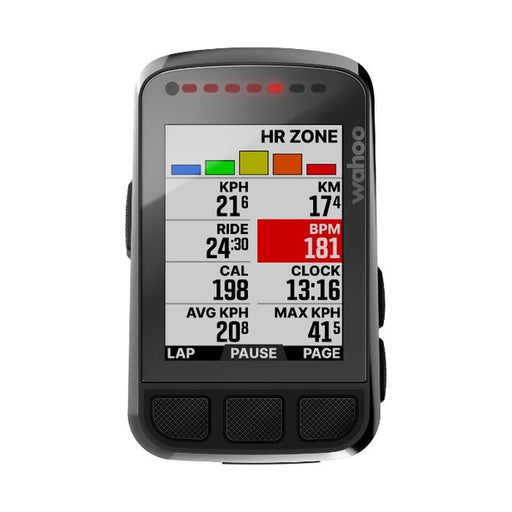
Bicycle navigation
Der Wahoo ELEMNT ACE ist ein hochmoderner Fahrradcomputer, der speziell für ambitionierte Radfahrer und Profis entwickelt wurde. Er kombiniert...
View full detailsDer Wahoo ELEMNT BOLT V2 ist der perfekte GPS-Fahrradcomputer für ambitionierte Radfahrer, die Wert auf präzise Daten, nahtlose Integration und aer...
View full detailsScope of delivery: wahoo computer, charging cable and handlebar mount
Everything you need to know about bike navigation systems
Functionality of bike computers and GPS navigation devices
Wired and wireless bike computers
Advantages and disadvantages of wired systems
- Pros: Wired bike computers provide more accurate data in real time because they are connected directly to the sensors and do not require wireless signal transmission. These systems are also generally more energy efficient because they do not require batteries for wireless communication, so you don't have to worry as much about changing batteries. Since there is no radio transmission, wired systems are less susceptible to interference that could affect data transmission.
- Cons: The main problem with wired systems is cable management. The wiring can look messy and there is a risk of the cable breaking or becoming tangled, especially if you don't secure it properly. Wired systems offer less flexibility in mounting and can be damaged in a fall if the cable breaks.
Advantages and disadvantages of wireless systems
- Pros: Wireless systems are easier to install as they don't require any wiring. Also, since there are no wires, you have more flexibility in where you place the computer and sensors. This can be especially useful if you have multiple bikes or change computers frequently. Wireless systems have a tidy cockpit with no annoying wires, which improves the overall look of your bike.
- Cons: Wireless systems tend to have higher power consumption due to wireless communication, which means you may need to charge or replace the batteries more often. Wireless systems can be more susceptible to interference that affects wireless signal transmission, especially in high traffic areas.
How your bike navigation system works
Assembly and installation of bike computers
The installation of sensors and accessories such as cadence sensors or heart rate monitors is also crucial for the smooth functioning of your bike computer. Make sure that the magnet and coil for speed measurement are correctly positioned and attached. The distance between the magnet and coil should not be greater than five millimeters. For wired systems, lay the cable neatly from the handlebars to the fork to avoid disruptive influences while riding.
To make the installation of your bike computer and accessories as easy as possible, you should read the included installation instructions carefully. Manufacturers usually include brackets, cable ties and rubber bands to help you attach everything safely and securely. Remember to measure the rolling circumference of your tire precisely and enter it into the device to get accurate speed and distance data.
Waterproofness of Bicycle Computers
The protection classes for bike computers range from IPX0 to IPX8. A device marked IPX0 offers no protection against water, while a device marked IPX8 offers protection against continuous submersion. It is important to note that some devices also have a number after the "X" that indicates protection against dust and foreign objects.
The waterproofness of a bike computer can have a significant impact on its durability. If your bike computer is well protected against water, you can use it without worry even in bad weather or on muddy trails.
Advantages of GPS navigation systems for cyclists
MYVELO bike navigation systems are robustly built and can withstand the stresses of cycling. They are protected against water and dirt, so you can use them in any weather without worry. The large display gives you a clear overview of your route, so you can concentrate fully on cycling without having to constantly look at your navigation system.
Purchase criteria for bike navigation systems
Your navigation system should be easy to use so that you can concentrate fully on riding. The integration of external sensors helps you to record additional data such as speed or cadence. Robust construction and water resistance ensure that your navigation system can withstand all weather conditions and will serve you faithfully for a long time.
Differences to navigation apps and conventional GPS devices
Bike navigation devices are also different from regular GPS devices. They offer special bike routing features to help you find the best routes for your bike rides. In addition, they have power and speed measurement data fields that provide you with important information while you ride. The mounts are specially designed to be attached to the handlebars of the bike, which allows for easy and secure installation.
Bike navigation systems offer many advantages over smartphones, including longer battery life and better readability of the display. They also save data volume. Functions of bike computers and GPS navigation devices range from basic functions to advanced features such as altitude and heart rate measurement. The choice between wired and wireless systems depends on personal preference. Bike computers can be mounted easily and without tools, with flexible mounts for the handlebar or stem. Water resistance is guaranteed by international standards such as IPX classification. The accuracy of bike computers and navigation devices depends on various factors, including satellite signal quality. Bike navigation devices are particularly suitable for road bike, gravel and touring riders. They offer robust construction, long battery life and functions specifically for cyclists.
Further information and frequently asked questions zu Bicycle navigation
The most important information practically summarized in our FAQ
Suitable for bicycle navigation:
- Bicycle navigation systems (special GPS devices for bicycles)
- Smartphones with corresponding navigation apps
- GPS watches or trackers
Some of the most popular bike navigation apps are:
- Komoot
- Strava
- Google Maps (with bike mode)
- Bikemap
- Ride with GPS
- Naviki
Many navigation apps offer the ability to save maps and routes offline. This is particularly useful in areas with poor network coverage.
Yes, many modern bike navigation systems and apps offer voice prompts so you can follow the route without having to constantly look at the screen.






